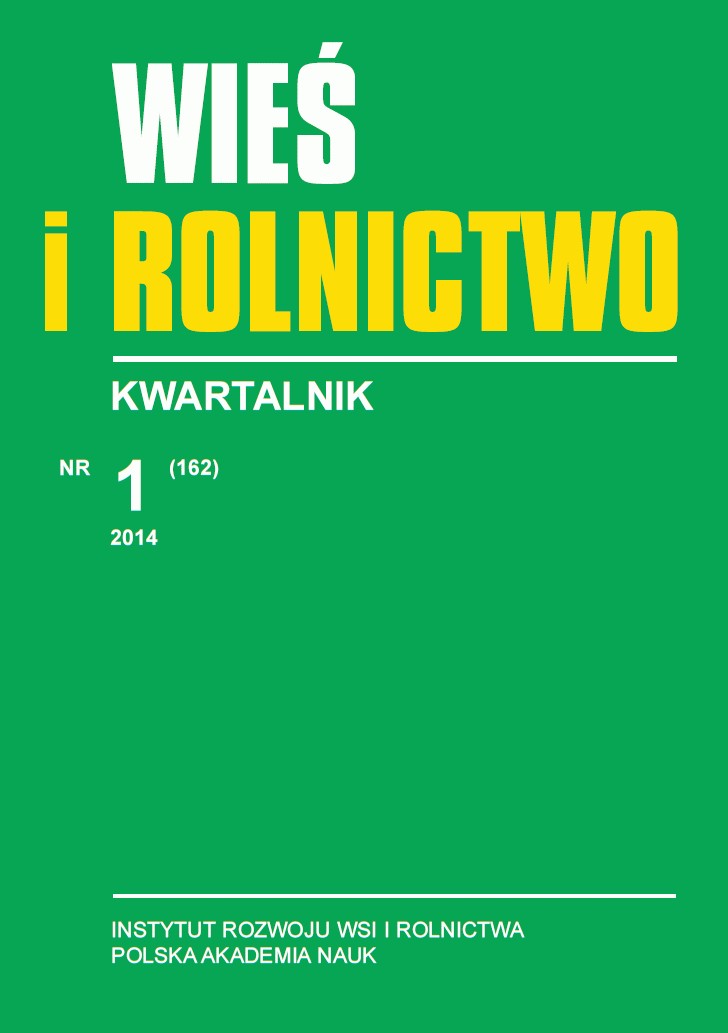The influence of the abolition of quotas on sugar beet and sugar production in the European Union
DOI:
https://doi.org/10.53098/wir.2014.1.162/10Keywords:
sugar beet production, EU’s sugar production, sugar quota, the simulation of sugar market situationAbstract
The aim of the study is to assess the situation in the sugar beet production and sugar processing in the European Union and its projection for 2020, assuming the impact of the expected abolition of sugar quotas in 2017. The study was conducted using the model CAPRI (Common Agricultural Policy Regionalised Impact). CAPRI is a partial equilibrium model of the agricultural sector, enabling the analysis of the impact of changes in agricultural policy on the agricultural sector in the European Union at national and regional level. The results of model simulations showed that in the EU-27 the liquidation of the quota system is expected to decline in the area under sugar beet and, consequently, a reduction in the production of both beet and processed white sugar. Contrary, this production in Poland is expected to increase. This may be due to the fact that, in relation to other major producers in the EU sugar beet and sugar production in Poland still remains less capital intensive.References
Adenauer M., 2008: CAPRI versus AGLINK-COSIMO. Two partial equilibrium models – Two baseline approaches. 12th Congress of the European Association of Agricultural Economists.
Agrosynergie, 2011: EVALUATION OF CAP MEASURES APPLIED TO THE SUGAR SECTOR, Groupement Européen d’Intéret Economique, European Commission DG Agriculture and Rural Development Report – December 2011.
Artyszak A., 2013: Zmiany w produkcji cukru w Polsce na tle Unii Europejskiej w pierwszej dekadzie XXI wieku. Problemy rolnictwa światowego, tom 13 (28), SGGW, Warszawa. DOI: https://doi.org/10.22630/PRS.2013.13.1.1
Balance sheet, single CMO Management Committee, www.ec.europa.eu/agriculture/sugar, data dostępu 30.08.2013 r.
Britz W., Witzke P., 2008: CAPRI model documentation 2008: Version 2. Institute for Ford Resource Economics, University of Bonn, Bonn.
Budzyńska A., 2011: Wpływ procesów globalizacyjnych na rynek cukru w Unii Europejskiej. Prace Naukowe Uniwersytetu Ekonomicznego we Wrocławiu nr 166, s. 81–92.
Gohin A., Bureau J., 2006: Modelling the EU sugar supply to assess sectoral policy reforms, European Review of Agricultural Economics, vol. 33 (2) 2006, s. 223–247 DOI: https://doi.org/10.1093/erae/jbl006
Mitchell D., 2005: Sugar policies: opportunity for change. [w:] Global Agricultural Trade and Developing Countries, A. Aksoy, J.S. Beghin (red.). The World Bank.
Nolte S., Buysse J., Van Huylenbroeck G., 2012: Modelling the effects of an abolition of the EU sugar quota on internal prices production and imports. European Review of Agricultural Economics vol. 39 (1), s. 75–94. DOI: https://doi.org/10.1093/erae/jbr043
Pörksen N., 2012: Sustainability – an integrated part of the beet sugar industry from customer to grower. Abstracts of Papers 73rd IIRB Congress, 14–15.02.2012 r., Bruksela, s. 3–4.
Poczta W., Sadowski A., Baer-Nawrocka A., 2013: Gospodarstwa rolne w Polsce na tle gospodarstw Unii Europejskiej. Wyd. GUS.
Europejski Związek Producentów Cukru, 2012 rok, www.cefs.org, data dostępu 1.09.2013 rok.
Stowarzyszenie Techników Cukrowników STC, www.stc.pl
Szajner P., 2009: Ocena wpływu reformy systemu regulacji rynku cukru w Unii Europejskiej na polski przemysł cukrowniczy. Zeszyty Naukowe SGGW w Warszawie – Problemy Rolnictwa Światowego, t. 8 (23). DOI: https://doi.org/10.22630/PRS.2009.8.46
Urban R., 2004: Przemiany przemysłu spożywczego w latach 1988–2003. Studia i Monografie, nr 121, IERiGŻ-PIB, Warszawa.
Downloads
Article file downloads
Pages
How to Cite
Issue
Section
License
Copyright (c) 2014 Wieś i Rolnictwo

This work is licensed under a Creative Commons Attribution 4.0 International License.










